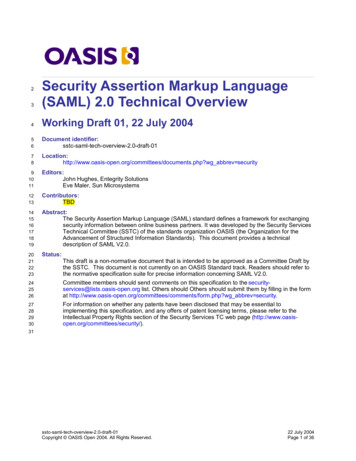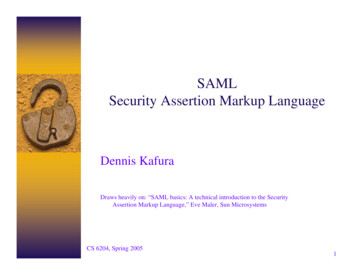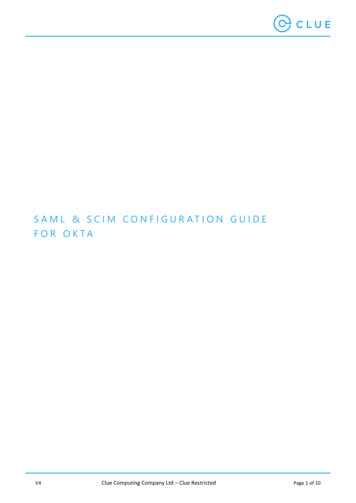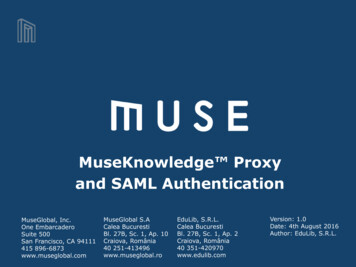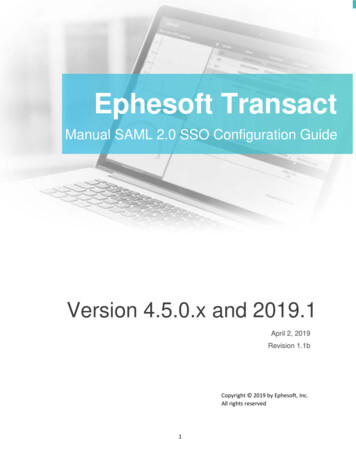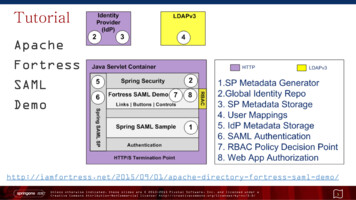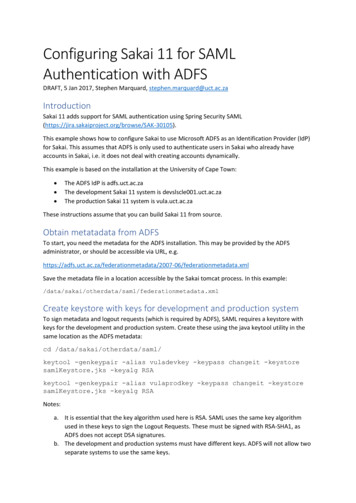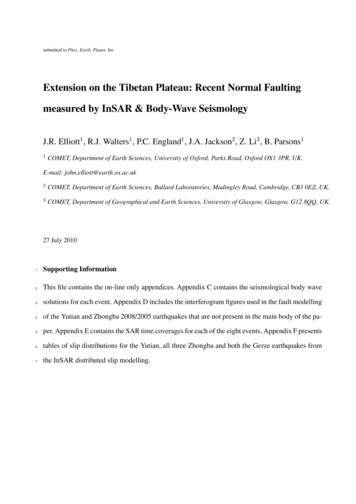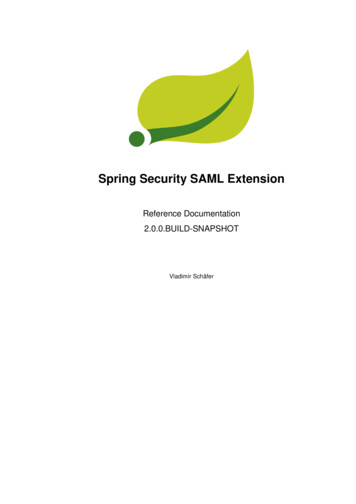
Transcription
Spring Security SAML ExtensionReference Documentation2.0.0.BUILD-SNAPSHOTVladimír Schäfer
Copyright 2009-2014 Vladimír Schäfer
Spring Security SAML ExtensionTable of ContentsI. Getting Started . 11. Introduction . 21.1. What this manual covers . 21.2. When to use Spring Security SAML Extension . 21.3. Features and supported profiles . 21.4. Requirements . 31.5. Source code . 31.6. Builds . 31.7. License . 31.8. Issue tracking . 31.9. Contributions . 31.10. Commercial support . 31.11. Community support . 41.12. Dependencies . 42. What's new . 52.1. New features, improvements and fixes in 1.0.1.FINAL . 52.2. New features, improvements and fixes in 1.0.0.FINAL . 52.3. Important code changes in 1.0.0.FINAL . 63. Glossary . 84. Quick start guide . 104.1. Pre-requisites . 104.2. Installation steps . 10Downloading sample application . 10Configuration of IDP metadata . 10Generation of SP metadata . 11Compilation . 11Deployment . 11Uploading of SP metadata to the IDP . 114.3. Testing single sign-on and single logout . 12II. Configuring SAML Extension . 135. Overview . 146. Integration to applications . 156.1. Maven dependency . 156.2. Bean definitions . 156.3. Java-based configuration . 156.4. Spring Security integration . 156.5. Error handling . 166.6. Logging . 167. Metadata configuration . 177.1. Service provider metadata . 17Automatic metadata generation . 17Pre-configured metadata . 19Downloading metadata . 207.2. Identity provider metadata . 21File-based metadata provider . 21HTTP-based metadata provider . 21HTTP-based metadata provider with SSL . 212.0.0.BUILD-SNAPSHOTSpring Security SAML Extensioniii
Spring Security SAML ExtensionMetadata signature verification .7.3. Extended metadata .7.4. Multi-tenancy and entity alias .8. Security configuration .8.1. Key management .Sample JKS keystore .Generating and importing private keys .Importing public keys .Loading SSL/TLS certificates .8.2. Security profiles .Metadata interoperability profile (MetaIOP) .PKIX profile .Custom profile .8.3. Hostname verification for HTTPS connections .9. Single sign-on configuration .9.1. IDP selection and discovery .9.2. Single sign-on process .Service provider initialized SSO .Identity provider initialized SSO .9.3. Logout process .Local logout .Global logout .9.4. Authentication object .9.5. Authentication assertion .9.6. Authentication log .10. Advanced configuration .10.1. Reverse proxies and load balancers .10.2. Context provider .10.3. Validity intervals .10.4. Enhanced client/proxy .10.5. Endpoint URLs .10.6. Artifact resolution .III. Sample application .11. Sample application .11.1. SAML login .11.2. Metadata administration .11.3. Metadata generation .IV. Integration guide .12. Integrating Identity Providers .12.1. Active Directory Federation Services 2.0 (AD FS) .Initialize IDP metadata .Initialize SP metadata .Test SSO .12.2. Okta .Deploy Spring SAML sample application .Configure Okta .Import Okta metadata to Spring SAML .Test SSO .13. Troubleshooting common problems .2.0.0.BUILD-SNAPSHOTSpring Security SAML 7484950iv
Part I. Getting StartedThis chapter provides essential information needed to enable your application to act as a serviceprovider and interact with identity providers using SAML 2.0 protocol. Later in this guide you can findinformation about detailed configuration options and additional use-cases enabled by this component.
Spring Security SAML Extension1. Introduction1.1 What this manual coversThis manual describes Spring Security SAML Extension component, its uses, installation, configuration,design and integration possibilities.1.2 When to use Spring Security SAML ExtensionThe extension enables both new and existing applications to act as a Service Provider in federationsbased on Web Single Sign-On and Single Logout profiles of SAML 2.0 protocol. The extension allowsseamless combination of SAML 2.0 and other authentication and federation mechanisms in a singleapplication. All products supporting SAML 2.0 in Identity Provider mode (e.g. ADFS, Okta, Shibboleth,OpenAM, Efecte EIM or Ping Federate) can be used with the extension.The extension can also be used in applications which are not primarily secured using Spring Security.It can be adapted for both single and multi-tenant environments.The extension can be either embedded inside your application and work along other authentication orsingle sign-on mechanisms, or it can be deployed separately and convey authentication information toapplications using a custom mechanism.The extension is probably the most complete open-source SAML 2.0 SP implementation with the widestfeature-set and configuration possibilities. Other Java open-source alternatives are e.g. native SAMLservice providers integrating with IIS or Apache from Shibboleth (SAML processing is done on the webserver and not on the application level) or OpenAM Fedlet.1.3 Features and supported profilesCurrent implementation should be conformant to SAML SP Lite and SAML eGovernment profile. Thefollowing profiles, bindings and features are supported as part of the product: Web single sign-on profile Web single sign-on holder-of-key profile IDP and SP initialized single sign-on Single logout profile Enhanced client/proxy profile Identity provider discovery profile and IDP selection Metadata interoperability and PKIX trust management Automatic service provider metadata generation Metadata loading from files, URLs, file-backed URLs Processing and automatic reloading of metadata with many identity providers Support for authentication contexts Logging for authentication events Customization of both SP and IDP metadata Processing of SAML attributes and user data using UserDetails interface Support for HTTP-POST, HTTP-Redirect, SOAP, PAOS and Artifact bindings Easy integration with applications using Spring Security Sample application with an user interface for quick configurationYou can use the following supported standards as a reference:2.0.0.BUILD-SNAPSHOTSpring Security SAML Extension2
Spring Security SAML ExtensionSAML 2.0 basic profiles -core-2.0-os.pdf -metadata-2.0-os.pdf -profiles-2.0-os.pdf -authn-context-2.0-os.pdf -bindings-2.0-os.pdf -conformance-2.0-os.pdfSAML 2.0 additional profiles stc-saml-holder-of-key-browser-sso.pdf stc-saml-idp-discovery.pdf stc-saml2-holder-of-key.pdf stc-metadata-iop.pdfeGovernment profile pdf1.4 RequirementsSpring Security SAML Extension requires as a minimum Java 1.6 and is known to work with most Javacontainers and application servers. It can also be used with PaaS providers, such as Google App Engine,please see ae for details.1.5 Source codeSource code for the project is maintained on Github.1.6 BuildsSnapshot builds of the project are available in the SpringSource repository. We use Bamboo forcontinuous integration.1.7 LicenseSource code of the module is licensed under the Apache License, Version 2.0. You may obtain copy ofthe license at http://www.apache.org/licenses/LICENSE-2.0.1.8 Issue trackingPlease use Spring Security Extensions Jira for submitting of bugs and feature requests. Patches canbe sent directly to GitHub as pull requests, but preferably open a Jira issue as well.1.9 ContributionsPlease send your pull requests directly to GitHub and preferably also open issue in Jira.1.10 Commercial supportFor commercial support and consulting services please contact sales@v7security.com2.0.0.BUILD-SNAPSHOTSpring Security SAML Extension3
Spring Security SAML Extension1.11 Community supportFor community support please use Stack Overflow. The Spring Security forums contain some previouslyanswered questions, but are now in read-only mode.1.12 DependenciesInternal processing of SAML messages, marshalling and unmarshalling is handled by OpenSAML.Spring SAML has a transitive dependency to library not-yet-commons-ssl. Inside Spring SAML thislibrary is only used for hostname verifications and will be removed in case OpenSAML removes thedependency.2.0.0.BUILD-SNAPSHOTSpring Security SAML Extension4
Spring Security SAML Extension2. What's newThis section contains overview of important changes for released versions of Spring SAML.2.1 New features, improvements and fixes in 1.0.1.FINALVersion 1.0.1.FINAL is fully backwards compatible with 1.0.0.FINAL and contains the following changes: Added support for Spring Security 4.0Added integration guide with OktaMaxAuthenticationAge time supports longer expiration times than 21 daysDeployment without JKS keystore is now supportedService provider can now define multiple assertion consumer endpoints with same bindingMinor fixes and documentation improvements2.2 New features, improvements and fixes in 1.0.0.FINALFinal release is not directly compatible with the previous RC versions, please make sure to migrate yourcode based on guidelines and changes below: Metadata signing now supports custom keyInfoGenerator and signingAlgorithm, signing can beenable per-entity sforPKIXTrustEvaluator,PKIXInformationResolver and MetadataResolver CertPathPKIXTrustEvaluator supports customization of security provider and explicit validation ofcertification path MetadataCredentialResolver can be configured to load data from XML metadata and/orExtendedMetadata PKIXInformationResolver has an extension point for population of CRLs Improvements to logging and error handling, profile implementations now throw exceptions which arelogged inside filter objects and fail with ServletExceptions, sample application newly shows handlingof these errors Used OpenSAML version was updated to 2.6.1 SAMLDefaultLogger now logs additional information such as NameID Enabled propagation of defaults (e.g. ProxySettings) set in the HttpClient object for ArtifactResolution JKSKeyManager now supports keystores without password SAMLContextProviderLB now supports empty contextPath and includes pathInfo data for requests Entity ID and EntityDescriptor ID can now be set separately in MetadataGenerator ECP now takes precedence over discovery in SAMLEntryPoint Signing of local metadata is now done before displaying, this enables manual modifications tometadata in local files ArtifactResolutionProfileImpl now support customization of used SocketFactory through extensions ID in generated metadata is now automatically created when null, ID is based on entityID cleanedin order to conform to xsd:ID (and xsd:NCName) type, EntityID is cleaned by replacing all illegalcharacters by underscores Support for hostname verification in artifact resolution Completed documentation Possibility to exclude the SAML Credential from the Authentication object Disabled deferred node expansion for ParserPool which improves performance in parsing of smallXML documents2.0.0.BUILD-SNAPSHOTSpring Security SAML Extension5
Spring Security SAML Extension
Spring Security SAML Extension requires as a minimum Java 1.6 and is known to work with most Java containers and application servers. It can also be used with PaaS providers, such as Google App Engine,
